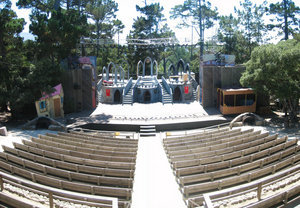Advertisement
Published: November 8th 2009

 CARMEL'S FOREST THEATER
CARMEL'S FOREST THEATER
CELEBRATES ITS 100 ANNIVERSAY IN 2010Excerpt from my book OUR SUMMER IN CARMEL: AMAZON.COM
It was during the time at the beginning of the century that San Francisco became a lure for playwrights, poets, authors, actors and actresses, which altogether comprised a bohemian society. Frank Powers, who was Devendorf's partner in the Carmel Development Company, and who was well-known to that bohemian circle, and espousing the virtues of his newly founded “Walden,” certainly attracted artists to experience the tranquil, forested, raw-natured seaside of, Carmel.
Avant-garde artists about that time were seeking a refuge where they could indulge in the current idea that artists should lead simple lives thereby sharpening their artistic sensitivities. In Carmel they could farm and graze what food they needed, harvest the abundant abalone, take fish from the rivers, and hunt in the woods. Frequent abalone feasts on the beach became the norm and spontaneous outpourings of poetic verse were common.
Leading this artistic movement to Carmel was the poet, George Sterling. He came to Carmel to be with “just one woman,” his wife, and to leave the drinking and the womanizing life of San Francisco behind. He was thirty-six in 1905. His “following” followed him. Jack London and Mary

 CARMELS BOHEMIAN CLIQUE
CARMELS BOHEMIAN CLIQUE
MARY AUSTIN, JACK LONDON, GEORGE STERLING AND JIMMIE HOOPERAustin; later Upton Sinclair and a young Sinclair Lewis. Painters followed, awed by Carmel’s natural but wild seacoast, exquisite light, ocean and surf, mountains and sea. It was a special time for all of them. They lived like children in a rarified warp of time. They had picnics on the beach at sundown, toiled during the day to eke out a living on the land, and at night gathered together for wine and talk, all the while encouraging each other’s talent and creativity. Bohemian enclaves are heady wine for the young, the naïve, and the self-sufficient. They do not outlast life’s reality. Jack London died of kidney disease in 1916. Sterling’s wife did not find matrimonial solace in escaping to the woods of Carmel and the promise of “just one woman.” She took her life by cyanide a few years after London’s passing. A decade later Sterling killed himself by the same means.
This episode in Carmel’s history is covered in excellent detail by Franklin Walker in The Seacoast of Bohemia. Many of the early bohemians drifted away. Yet, a core few remained, becoming the seed of Carmel’s cultural future. The word was out. Carmel held a special promise for those seeking solitude, those who wanted to create, those who dared to think and act differently. It was out of those early years from which today’s Forest Theater sprung, as well as the Golden Bough Theater, the many renowned art and music festivals, and the profusion of artists, actors, playwrights and others with a creative aptitude who continue to live there today and, although in a very different commercial climate make Carmel today a special place.
Advertisement
Tot: 0.317s; Tpl: 0.011s; cc: 7; qc: 44; dbt: 0.0588s; 1; m:domysql w:travelblog (10.17.0.13); sld: 1;
; mem: 1.4mb

 CARMEL'S FOREST THEATER
CARMEL'S FOREST THEATER
 CARMELS BOHEMIAN CLIQUE
CARMELS BOHEMIAN CLIQUE